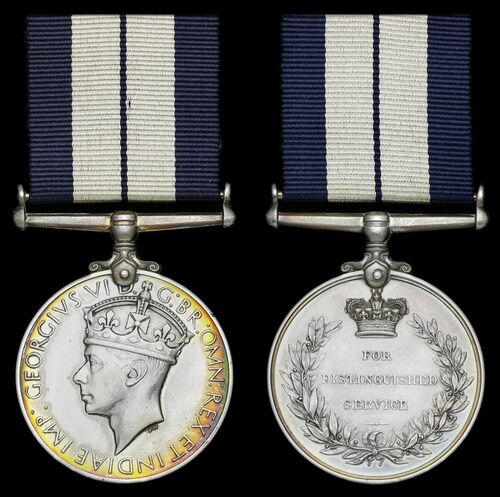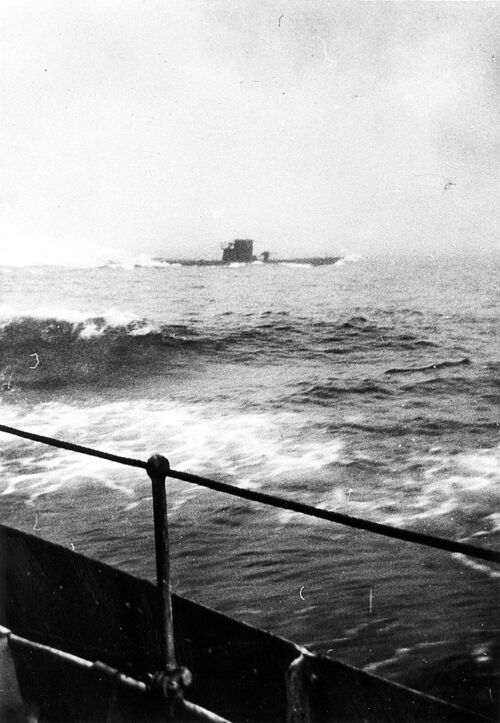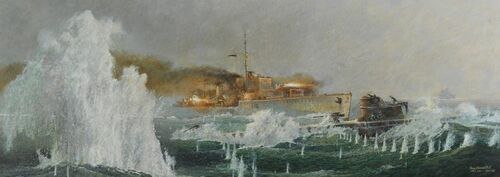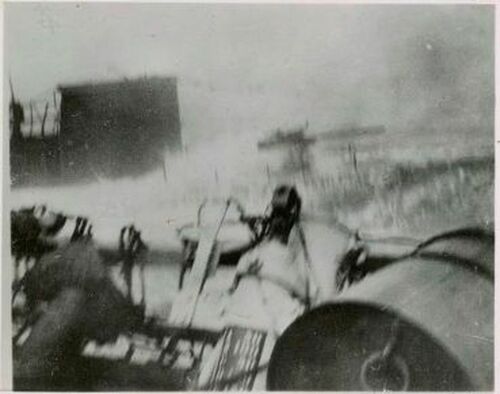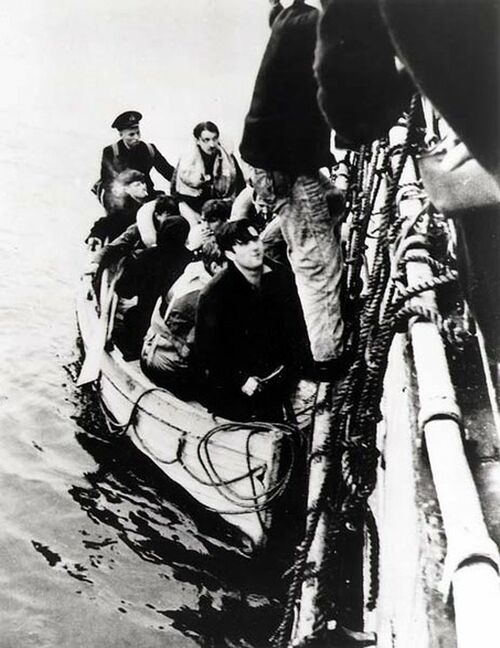Auction: 23002 - Orders, Decorations and Medals
Lot: 87
(x) 'The submarine opened fire with all his guns and for about 35 minutes the action continued at a point blank range of about 100 to 300 yards.'
An account of the remarkable action which earned Costello his D.S.M.
The outstanding 1942 D.S.M. awarded to Leading Seaman E. Costello, Royal Canadian Navy Volunteer Reserve, who earned his reward in the close-quarters epic which sunk the U-210, an event that was heavily photographed
Distinguished Service Medal, G.VI.R. (V.5597 E. Costello. T/A. L. Smn. R.C.N.V.R.), good very fine
Approximately 64 D.S.M.'s issued to the Royal Canadian Navy Volunteer Reserve for the Second World War.
D.S.M. London Gazette 3 December 1942 and Canada Gazette 12 December 1942. The Recommendation states:
For courage and enterprise before the enemy. During the successful action between HMCS Assiniboine and an enemy U-Boat, this rating was in charge of a 0.5 multiple machine gun. The coolness and courage of the highest order which he exhibited enabled him to maintain extraordinarily accurate fire which prevented the enemy U-Boat crew from reaching their forward gun. By his accurate fire, he made a decisive contribution to the success of the action.'
Earl Costello was born on 1 August 1920 at Montreal and was a mechanic by trade upon his joining 'B' Squadron, 17th Duke of York's Royal Canadian Hussars on 24 November 1938. Discharged on 14 February 1939, he joined the Royal Canadian Navy Volunteer Reserve on 2 October 1939.
Epic action - U210 sunk
A fine account of the action in which Costello won his D.S.M. was penned in Legion by Marc Milner:
'Fire And Fog: The Assiniboine Rams U-210
The attack on convoy ON 115 in late July and early August 1942 was the last in a long series of U-boat assaults on Canadian or largely Canadian-escorted westbound convoys dating back to May. The next convoy to be attacked was eastbound. But it, too, was largely escorted by the Royal Canadian Navy, and it produced yet more high drama in the fog of the Grand Banks.
Convoy SC 94 sailed from Sydney, N.S., on July 31 with 30 ships destined for Liverpool. Its mid-ocean escort, group C.1, joined on the day ON 115 was attacked by Wolf Pack Group Pirat just a few kilometres away.
At this stage in the war, C.1 was normally only half RCN. Its corvettes, Dianthus, Nasturtium and Primrose, were British and Aconit was Free French. The Canadian corvettes Battleford, Chilliwack and Orillia, and the Canadian destroyers Assiniboine and St. Croix composed the core of the group. St. Croix, detached for anti-submarine exercises in Conception Bay, Nfld., was on the sidelines for SC 94, and Lieutenant-Commander J.H. Stubbs, RCN, Captain of Assiniboine, deferred command of the group to the more experienced and older Lt.-Cmdr. A. Ayer, Royal Navy Reserve, of Primrose.
The early phase of the battle for SC 94 was all about Stubbs. Dense fog foiled most attempts by Royal Canadian Air Force and United States aircraft to find SC 94 from 3-5 August, and disrupt Group Pirat as it hurried back into the mid-ocean to establish a new patrol line.
On 5 August, U-593, at the northern end of Group Pirat, stumbled onto an errant portion of SC 94 that had lost its way in the fog. One attack sank the 3,616-ton Dutch cargo ship Spar, but counterattacks by Orillia and Nasturtium drove off U-593 and U-595. The convoy reunited later in the day.
Meanwhile, Assiniboine conducted sweeps nearby, and through clear patches in the fog, her Captain could see the convoy’s smoke some 50 kilometres away. So could the Germans. By 6 August, 11 U-boats were on their way to intercept SC 94.
Assiniboine found U-595 trying to close on the convoy again that morning, and she managed to drive the U-boat down with her gunfire. Later, three U-boats, closing on SC 94 from astern, were sighted by Dianthus and Assiniboine. It was while chasing these subs that Assiniboine’s outdated Type 286 radar obtained a contact in a patch of thick fog. The contact turned out to be U-210.
The U-boat was on her first war cruise. She had a new skipper, Kapitanleutant Rudolph Lemcke, and survivors’ reports suggest U-210 was not a happy boat. Lemcke had been cashiered as an officer in 1940 for disciplinary brutality and failing to follow regulations, and perhaps served several months in a penal Battalion. Following a probationary period in minesweepers, he was recommissioned as an officer in the U-boat service and did one cruise as an understudy. When Lemcke took command of U-210 he was promoted to Oberleutenant, and was restored to his previous rank of Kapitanleutnant the day U-210 left Kiel for France.
Lemcke clearly had something to prove. So, too, did his executive officer, Gunther Göhlich, who the United States Navy’s interrogation report described as a “fanatical Nazi, arrogant and conceited. He had all the makings of a youthful martinet and was most unpopular on board.”
The engineer, Heinz Sorber, was capable, well-liked and a known anti-Nazi. The chief characteristics of the crew, according to the USN report, were youth and inexperience.
When U-210 steamed into heavy fog around 8 p.m. on 6 August, Lemcke went below for his dinner. Gilbert Tucker, the RCN official historian who was on Assiniboine for passage to England, later reported that U-210 appeared “out of the mist…some 50 yards away, and about across our bows.”
Assiniboine had no chance to fire, and when U-210 slipped back into the fog she might well have gone down like a stone the way Sackville’s second U-boat did a few days earlier. But it seems that no one on U-210’s conning tower saw the destroyer during that fleeting moment, and the U-boat missed her chance to submerge.
The first Lemcke knew that the enemy had found him was when he heard shouts and gunfire echoing down into U-210 from the open hatches.
By then Stubbs had closed on U-210 at high speed, dropping the range quickly from roughly 1,100 to perhaps 180 metres and - by all accounts - emerging suddenly from the fog. The recent RCN official history states that “the guns of both ships erupted at point-blank range.” Lemcke, who had returned to the open conning tower, threw U-210 into a series of wild manoeuvres. Assiniboine was so close that Stubbs could watch Lemcke leaning over to pass helm instructions. C.P. Van der Hagen, a gunnery rating in a fire control position on the destroyer’s bridge, recalled Stubbs ordering the ship to ram. He then saw “this little dark thing in the fog, and he was running.”
Once the high-speed chase started, Lemcke had two choices. He could get U-210 on a steady course long enough to dive or he could fight it out. The trick for Stubbs was to keep U-210 turning so she couldn’t dive, keep his own guns firing and watch for an opportunity to ram. He helped Assiniboine through her tight turns by shifting port or starboard screws into reverse as required. That prevented U-210 from turning inside the destroyer and perhaps ramming her. However, these manoeuvres did not stop the U-boat from firing on the ship.
Apart from six torpedo tubes, U-210 carried an 88-mm deck gun forward and a 20-mm anti-aircraft gun on the conning tower. These were no match for Assiniboine’s 4.7-inch guns, but the destroyer was often too close for these to be of any use. So it became primarily a duel between Assiniboine’s .50-calibre machine guns, which kept Lemcke from manning his unshielded 88-mm deck gun, and the 20-mm fire from U-210’s secondary armament.
This macabre dance went on in the fog for about 30 minutes and U-210 gave as good as she got. Her 20-mm rounds raked Assiniboine’s upper works, setting fire to gasoline and igniting a blaze that eventually engulfed a large portion of the bridge. The fire was intense, and it soon trapped the Chief Petty Officer at the helm, Max Bernays, in the wheelhouse.
Bernays carried on, executing Stubbs’ commands with calm efficiency and was later awarded the Conspicuous Gallantry Medal. Historians Fraser McKee and Ken Darlington, in their wonderful compendium, The Canadian Naval Chronicle 1939-1945, record that Chief Engine Room Artificer Don Portree led the firefighting team on deck, aft of the bridge. Portree was holding the fire hose alone when the water pressure came through and “was neatly flipped over the rails, holding onto the hose for dear life” as Assiniboine twisted and turned through the fog. The damage control party hauled him back on board.
By the time Stubb’s first Lieutenant, Ralph Hennessy, unable to use the bridge ladders because of the fire, slid down the mast to take charge, Portree’s crew had things under control. So Hennessy went below to check on damage. He found that 20-mm rounds from U-210 had ripped through the destroyer’s hull, slashing pipes, ripping up fittings and leaving the hull peppered by holes. But here, too, Assiniboine’s chiefs had damage control in hand. Hennessy found the men calmly driving wooden pegs into the holes in the hull as the battle raged.
Much of the sub’s fire was directed at Assiniboine’s bridge. Over 70 years later Hennessy could still recall Stubbs at his post amid a hail of 20-mm rounds - leaving him to wonder where that stoicism originated. Later, senior officers in the British Admiralty were less charitable, and chastised Stubbs for failing to keep a proper record of all his helm orders during that frantic 30 minutes. The fact that the bridge was on fire and that 20-mm rounds were passing through it and the charthouse behind at regular intervals moved Their Lordships not at all. In fact, Assiniboine was very fortunate in suffering only one fatality, Ordinary Seaman Ken W. Watson. He was an ammunition carrier for “A” gun on the foc’sle and was wounded early in the action. He stuck to his duty until a burst of fire from U-210 disabled the gun, wounded three of the gun’s crew, and killed him.
Shortly after that, Lemcke’s luck ran out, too. Assiniboine’s machine gunners finally silenced U-210’s 20-mm gun while the destroyer’s 4.7-inch gun put a round into the conning tower, killing Lemcke and his entire deck watch.
After a brief attempt to man the 20-mm gun and resume the battle, the U-boat’s senior surviving officer finally put U-210 on a straight course and tried to submerge. That gave Stubbs another chance. Assiniboine rammed the U-boat aft of the conning tower, but the destroyer was moving slowly enough that she simply glanced off and slid away as U-210 quickly descended to 18 metres.
When water began to pour into the U-boat, its senior surviving officer blew the ballast and brought U-210 to the surface, where Assiniboine was waiting. Stubbs rammed the sub again, in the same place, and then dropped shallow depth charges for good measure while a 4.7-inch shell hit the sub’s bow. With that, U-210 was finished.
Dianthus emerged from the fog, her crew cheering loudly, to see Assiniboine standing by the sinking sub. All but six of U-210’s crew of 43 were rescued.
With a charred bridge, buckled bow and wooden pegs protruding from holes in her sides, Assiniboine turned for St. John’s. The non-commissioned PoWs were locked in an unused boiler room, and fed by lowering buckets through an escape hatch. The two surviving officers from U-210 enjoyed the relative comfort of the doctor’s burned out cabin. Hennessy found the toughest sailor he knew to guard the door, giving him his pistol and an order to shoot if they tried to leave. The next day Hennessy and Bernays sewed Watson into a sheet of canvas, putting two tin cans full of weight at his feet to make sure his corpse sank. The youngest member of Assiniboine’s crew, and the only Canadian fatality of the action, was buried at sea with full honours.'
Costello was duly rewarded with his D.S.M. for his part in the epic duel which wrote itself into the naval history of Canada. The events were also captured in photographs, immortalising the event further.
Costello's character was perhaps effected by the events he had seen in action, for he went absent without leave for some 217hrs 30mins whilst going between Excellent and Niobe in the summer of 1943. He was also charged with stealing 11,500 Woodbine cigarettes, 3,500 Park Drive cigarettes, 122 dozen razor blades, 82 Valet razor blades, 6 dozen Toffee bars, 72 bottles of beer, 6 dozen packs of Mints, 4 boxes of matches (all NAAFI property) at 0030hrs on 16 August 1943. He was sentenced to 60 days detention at the Royal Naval Detention Quarters, Coatdyke and served 18 days before release. He was again in trouble for going absent without leave and returning drunk in March 1944 and then had the misfortune to jump from a truck onto a nail, which punctured his left foot on 25 June 1946 whilst with Donnacona.
Having been released, Costello died in December 1968 and his campaign Medals (1939-45 Star, Atlantic Star, Defence & War Medals 1939-45, Canadian Volunteer Service Medal & clasp) were issued in January 1986; sold together with copied research.
Subject to 5% tax on Hammer Price in addition to 20% VAT on Buyer’s Premium.
Sold for
£4,200
Starting price
£1200

